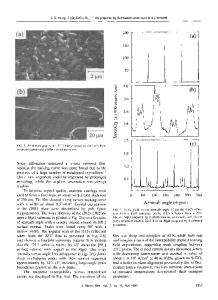Compressive creep of dense Bi 2 Sr 1.7 CaCu 2 O x
- PDF / 1,082,644 Bytes
- 5 Pages / 576 x 792 pts Page_size
- 5 Downloads / 324 Views
K. C. Goretta Materials and Components Technology Division, Argonne National Laboratory, Argonne, Illinois 60439-4838
D. J. Miller Materials Science Division, Argonne National Laboratory, Argonne, Illinois 60439-4838
D. B. Kazelas Materials and Components Technology Division, Argonne National Laboratory, Argonne, Illinois 60439-4838
C. Clauss and A. Dominguez-Rodrfguez Department of Condensed Matter Physics, Universidad de Sevilla, 41080 Sevilla, Spain (Received 28 February 1992; accepted 1 June 1992)
Dense polycrystalline Bi2Sr1.7CaCu20x (2212) was deformed from 780-835 °C in oxygen partial pressures, Po2, of 103 to 2 X 104 Pa. Results could be divided into two stress regimes: one at lower stress in which the steady-state creep rate, s, was proportional to stress, a, having an activation energy of 990 ± 190 kJ/mole and being independent of POl, and another at higher stress in which e was proportional to a", with n = 5-6. Transmission electron microscopy supported the interpretation that in the lower-stress viscous regime, creep was controlled by diffusion, whereas dislocation glide and microcracking were responsible for strain accommodation at higher stresses.
I. INTRODUCTION Little is known about cation diffusion in the B i - S r C a - C u - 0 high-temperature superconductors, despite its scientific and technological importance. Processes such as sintering and grain growth are controlled by diffusion of the slowest moving species. In the case of the B i - S r - C a - C u - 0 superconductors, the crystal structure would strongly suggest that the slowest moving species are the cations, Bi, Sr, or Ca. Ag, the only cation whose tracer diffusion has been measured in B i - S r - C a - C u - O , 1 but whose site occupancy has not been confirmed, diffuses at about the same rate as does oxygen in polycrystalline Bi 2 Sr 2 CaCu 2 O x (2212).2 Therefore, some knowledge of cation diffusion would be quite useful in constructing point defect models and in predicting optimum sintering procedures. Measurements of the high-temperature deformation of materials, in general, and superconductors, in particular, have yielded unique information about the kinetics of the slowest-diffusing species. It was shown, for example, that creep in YBa 2 Cu 3 0j, (YBCO) is diffusion controlled. A comparison of the activation energy for creep3 with those of cation diffusion4'5 measured later by tracer techniques suggests that the high activation energy for creep of 970 ± 130 kJ/mole (104 =s POl s= 105 Pa) reflects the activation energy for self-diffusion of Y, which is 1000 ± 200 kJ. Creep of YBCO is, however, 2360
http://journals.cambridge.org
quite complex. The activation energy decreases substantially to about 650 kJ/mole for POl of 1-3 X 103 Pa. Tracer diffusion coefficients of Ba in YBCO have been shown to be independent of PQ2 -4'5 The POl dependence of the diffusion of Y in YBCO has not been measured. These results have not been explained fully and future investigations are warranted. However, it may be postulated that in YBCO there i
Data Loading...











